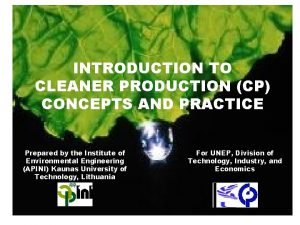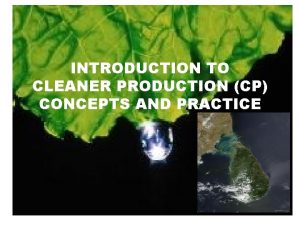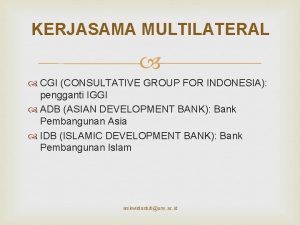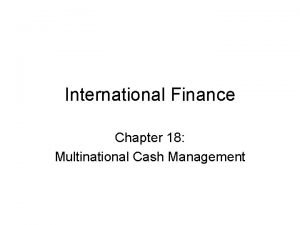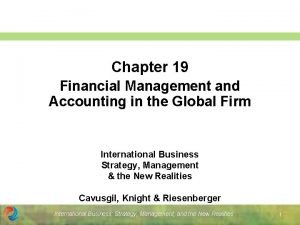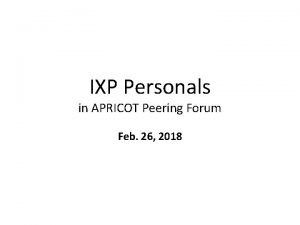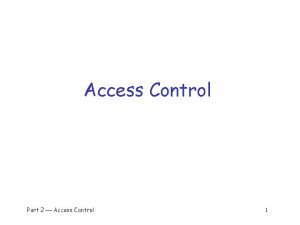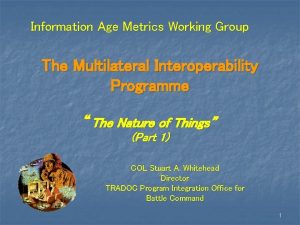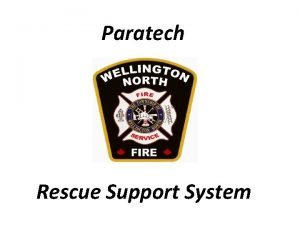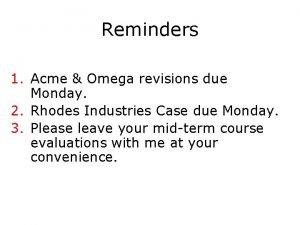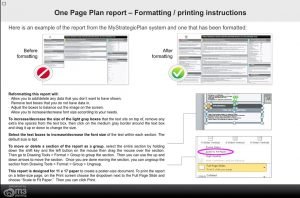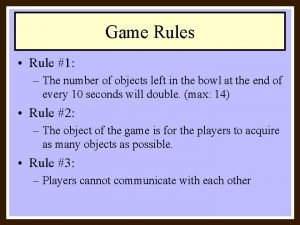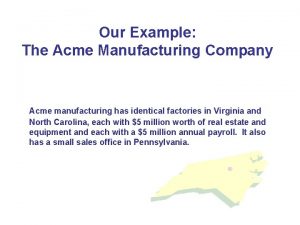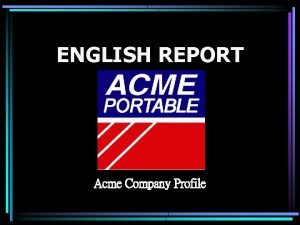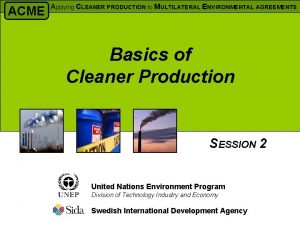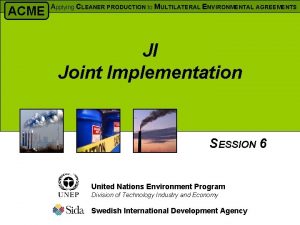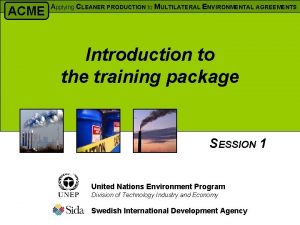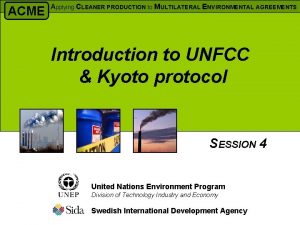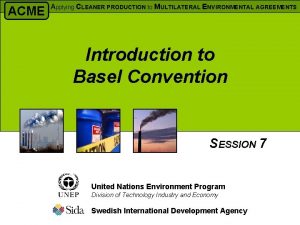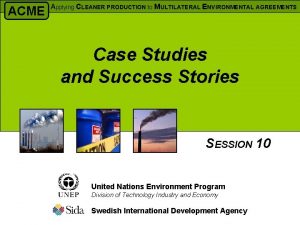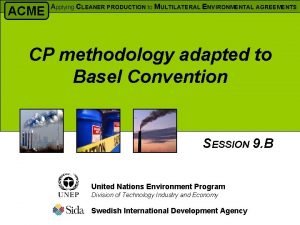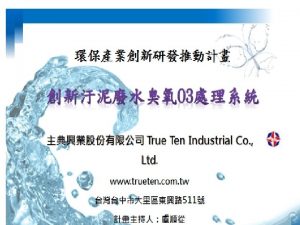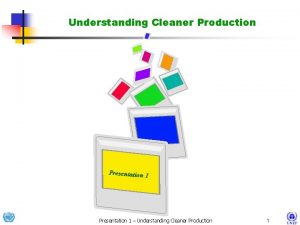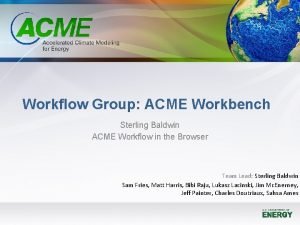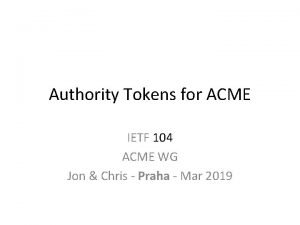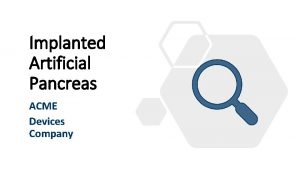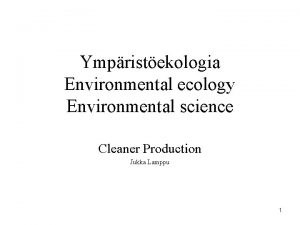ACME Applying CLEANER PRODUCTION to MULTILATERAL ENVIRONMENTAL AGREEMENTS

















- Slides: 17

ACME Applying CLEANER PRODUCTION to MULTILATERAL ENVIRONMENTAL AGREEMENTS Multilateral Environmental Agreements (MEAs) SESSION 3 United Nations Environment Program Division of Technology Industry and Economy Swedish International Development Agency

OUTLINE Objectives of this session 1/ Background information > Why do we need Multilateral Environmental Agreements? 2/ Main clusters > What topics do MEA deal with? > How industries are concerned? 3/ Organisation of MEA > How are they developed and organised? 4/ Implementation > How could we strengthen MEA? ACME - Session 3 - Multilateral Environmental Agreements - 2 / 17

BACKGROUND What are MEAs ? Many global environmental issues don’t stop at the border: > they are caused by sources thousands of kilometers away; > they can have a regional or even a global impact. MEAs are international legal instruments that: > have a goal of environmental protection (sustainable development); > take measures to remedy, mitigate or otherwise deal with global and/or regional environmental concerns; > are concluded between a large number of states or international organizations as Parties; > can be embodied in a single instrument or more related instruments; > are governed by international law; > are concluded in written form. ACME - Session 3 - Multilateral Environmental Agreements - 3 / 17

BACKGROUND Milestones in the evolution of MEAs 1972 - Stockholm Conference on the Human Development > First attempt to address relationship between environment and development at global level; > Adopted first global action plan for the environment; > Established UNEP. 1992 - Rio Conference on Environment and Development > National and international policies redirected towards integration of environmental, economic and social objectives; > 2 main outputs: Rio Declaration and Agenda 21; > Accelerated the development of modern MEAs: more than 60% of present MEAs established after 1992. ACME - Session 3 - Multilateral Environmental Agreements - 4 / 17

BACKGROUND Number of parties to MEAs Stockholm Conference (1972) Rio Conference (1992) ACME - Session 3 - Multilateral Environmental Agreements - 5 / 17

MAIN CLUSTERS Scope of MEAs: 5 topics BIODIVERSITY LAND SEAS CHEMICALS & HAZARDOUS WASTE ACME - Session 3 - Multilateral Environmental Agreements - 6 / 17 ATMOSPHERE

MAIN CLUSTERS Biodiversity / Land / Seas MEAs related to protection and conservation of BIODIVERSITY. > Convention on Biological Diversity (CBD); > Others include CITES, CMS, Ramsar Convention on Wetlands etc. MEAs focussing on protecting LAND from “negative altering”. > UN Convention to Combat Desertification (UNCCD); > 3 Rio Conventions linked to climate change and biodiversity. MEAs relevant to the regional seas & MARINE ENVIRONMENT. > 17 Regional Seas Conventions; > Global Program of Action for the protection of the marine environment from land-based activities (GPA). ACME - Session 3 - Multilateral Environmental Agreements - 7 / 17

MAIN CLUSTERS Atmosphere / Wastes & chemicals MEAs aimed at protection of the ATMOSPHERE from pollutants. > Montreal Protocol on substances that deplete the ozone layer; > UNFCCC (UN Framework Convention on Climate Change) and the linked Kyoto Protocol. MEAs dealing with hazardous WASTES & CHEMICAL pollution. > Basel Convention on the control of transboundary movement of hazardous wastes and their disposal; > Rotterdam Convention on the prior informed consent for certain hazardous chemicals and pesticides in international trade; > Stockholm Convention on Persistent Organic Pollutants (POPs). 3 MEAs with direct relevance to industrial activities. ACME - Session 3 - Multilateral Environmental Agreements - 8 / 17

ORGANISATION From negotiation to ratification How are MEA’s developed ? > A negotiation process between countries involved; > Often initiated and facilitated/moderated by UNEP; > Resulting in a mutual agreed and signed protocol during a highlevel tailored conference. How do MEAs come into force ? > Initial agreement (international legal instrument) are signed between the signatories (states); > MEAs include provision on number of ratification from signatories needed to come into force; > Once a country (or “Party”) ratifies, accepts, approves or accedes an MEA, it is subject to the provisions under the MEA. ACME - Session 3 - Multilateral Environmental Agreements - 9 / 17

ORGANISATION Key concepts Non-binding instruments “ Set out important issues and priorities, foster discussion and attention, and stimulate new thinking and development of legally binding instruments. ” Legally binding instruments “ Sets commitments in form of legally binding targets and time-tables. ” ACME - Session 3 - Multilateral Environmental Agreements - 10 / 17

ORGANISATION How do MEAs work ? IMPLEMENTATION > Converting international commitments into national measures. COMPLIANCE > Countries adhere to the agreement provisions and undertake implementation measures (e. g. national reporting). ENFORCEMENT > Formal (national or international) procedures and actions by which compliance is compelled or noncompliance deterred. EFFECTIVENESS > Whether a MEA resolves a problem that caused its creation. ACME - Session 3 - Multilateral Environmental Agreements - 11 / 17

ORGANISATION Institutional elements COP – Conference of Parties > Decision-making body on implementation and development of MEAs. Secretariat > Support to COP (provided by an international organization). Executive and subsidiary bodies > Generally advisory in nature, report to COP on scientific, technical, or financial matters. Clearinghouses > Facilitate exchange of information (websites, databases, etc. ). Implementation actors on national level > Represented by the national authorities and/or institutions, training and information centers. ACME - Session 3 - Multilateral Environmental Agreements - 12 / 17

ORGANISATION Financial mechanisms Regime budgets > Mandatory or voluntary trust funds administered by the Secretariats; > Proposed by Parties and approved by the COP. Development assistance > Funds provided via foundations (e. g. UN Foundation), bilateral arrangements, private sector donors and NGOs. > World Bank. Global Environment Facility (GEF) > A co-financing mechanism to address global environmental issues; > GEF focal areas : biodiversity, climate change, international waters, ozone depletion, POPs, land degradation. ACME - Session 3 - Multilateral Environmental Agreements - 13 / 17

IMPLEMENTATION Strengths & weaknesses of MEA’s STRENGTHS > Joint strategy to deal with global issues; > Clearly defines who should do what; > Conflict settlement instruments; > Provides increased attention to preventive - precautionary approach. WEAKNESSES > Lack of synergy among MEAs; > Inadequate funding for many MEAs; > Lack of performance indicators; > Inadequate coordination among MEA’s at national level; > No international enforcement mechanisms in most MEAs. ACME - Session 3 - Multilateral Environmental Agreements - 14 / 17

IMPLEMENTATION How to strengthen MEAs ? How to overcome the perceived weaknesses ? > More integrated application for specific targets groups (e. g. industry); > Utilization of other concepts/methodologies (e. g. Cleaner Production). How can Cleaner Production contribute to MEAs ? > Wider use of prevention as the strategy of environmental protection; > Issue linkage and providing positive incentives for compliance and implementation of MEAs; > Strengthening synergies among MEAs; > Adding flexibility to the agreements. ACME - Session 3 - Multilateral Environmental Agreements - 15 / 17

IMPLEMENTATION What can Cleaner Production do ? What are the advantages of cross-cutting capacity building activities of Cleaner Production initiatives and MEAs ? > Policy advice; > Technical and financial assistance; > Assessment and management of pollution; > Education and awareness; > Information exchange; > Strengthened participation of all stakeholders in the decision-making; > International partnership. ACME - Session 3 - Multilateral Environmental Agreements - 16 / 17

CONCLUSION End of session 3 Thank you for your attention… Any questions? ACME - Session 3 - Multilateral Environmental Agreements - 17 / 17
 Pre dan post production adalah
Pre dan post production adalah Cleaner production principles
Cleaner production principles Cleaner production principles
Cleaner production principles Multilateral competition games
Multilateral competition games Kerjasama cgi
Kerjasama cgi Netting finance
Netting finance Multilateral netting is used primarily to
Multilateral netting is used primarily to Multilateral peering osaka
Multilateral peering osaka The multilateral security enforces access control
The multilateral security enforces access control Multilateral interoperability programme
Multilateral interoperability programme Unilateral competition games examples
Unilateral competition games examples Paratech acme thread strut
Paratech acme thread strut Acme omega
Acme omega Acme corporation strategic plan
Acme corporation strategic plan Acme bolt trucking game
Acme bolt trucking game Acme manufacturing company
Acme manufacturing company Acme portable corp
Acme portable corp Acme toy company prints baseball cards
Acme toy company prints baseball cards

